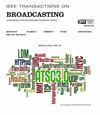基于体素变换和稀疏卷积的3D广播点云属性压缩
IF 4.8
1区 计算机科学
Q2 ENGINEERING, ELECTRICAL & ELECTRONIC
引用次数: 0
摘要
点云已经成为虚拟现实和增强现实等高级3D应用的主流代表。然而,点云的海量数据是传输和存储最具挑战性的问题之一。在本文中,我们提出了一种基于点云属性压缩(TSC-PCAC)的端到端体素变换和稀疏卷积的3D广播。首先,我们提出了TSC-PCAC的框架,其中包括基于变压器和稀疏卷积模块(TSCM)的变分自编码器和信道上下文模块。其次,我们提出了一个两阶段的TSCM,其中第一阶段侧重于对点云的局部依赖关系和特征表示进行建模,第二阶段通过包含更大接受域的空间和通道池来捕获全局特征。该模块有效地提取了全局和局部的点间关联,减少了信息冗余。第三,我们设计了一个基于TSCM的信道上下文模块,利用信道间的相关性,改善了量化潜在表示的预测概率分布,从而降低了比特率。实验结果表明,与稀疏pcac、NF-PCAC和G-PCC v23方法相比,TSC-PCAC方法在8iVFB、Owlii、8iVSLF、Volograms和MVUB数据集上的平均比特率分别降低了38.53%、21.30%和11.19%。与Sparse-PCAC相比,编码/解码时间成本平均降低了97.68%/98.78%。源代码和训练过的TSC-PCAC模型可在https://github.com/igizuxo/TSC-PCAC上获得。本文章由计算机程序翻译,如有差异,请以英文原文为准。
TSC-PCAC: Voxel Transformer and Sparse Convolution-Based Point Cloud Attribute Compression for 3D Broadcasting
Point cloud has been the mainstream representation for advanced 3D applications, such as virtual reality and augmented reality. However, the massive data amounts of point clouds is one of the most challenging issues for transmission and storage. In this paper, we propose an end-to-end voxel Transformer and Sparse Convolution based Point Cloud Attribute Compression (TSC-PCAC) for 3D broadcasting. Firstly, we present a framework of the TSC-PCAC, which includes Transformer and Sparse Convolutional Module (TSCM) based variational autoencoder and channel context module. Secondly, we propose a two-stage TSCM, where the first stage focuses on modeling local dependencies and feature representations of the point clouds, and the second stage captures global features through spatial and channel pooling encompassing larger receptive fields. This module effectively extracts global and local inter-point relevance to reduce informational redundancy. Thirdly, we design a TSCM based channel context module to exploit inter-channel correlations, which improves the predicted probability distribution of quantized latent representations and thus reduces the bitrate. Experimental results indicate that the proposed TSC-PCAC method achieves an average of 38.53%, 21.30%, and 11.19% bitrate reductions on datasets 8iVFB, Owlii, 8iVSLF, Volograms, and MVUB compared to the Sparse-PCAC, NF-PCAC, and G-PCC v23 methods, respectively. The encoding/decoding time costs are reduced 97.68%/98.78% on average compared to the Sparse-PCAC. The source code and the trained TSC-PCAC models are available at https://github.com/igizuxo/TSC-PCAC .
求助全文
通过发布文献求助,成功后即可免费获取论文全文。
去求助
来源期刊

IEEE Transactions on Broadcasting
工程技术-电信学
CiteScore
9.40
自引率
31.10%
发文量
79
审稿时长
6-12 weeks
期刊介绍:
The Society’s Field of Interest is “Devices, equipment, techniques and systems related to broadcast technology, including the production, distribution, transmission, and propagation aspects.” In addition to this formal FOI statement, which is used to provide guidance to the Publications Committee in the selection of content, the AdCom has further resolved that “broadcast systems includes all aspects of transmission, propagation, and reception.”
 求助内容:
求助内容: 应助结果提醒方式:
应助结果提醒方式:


